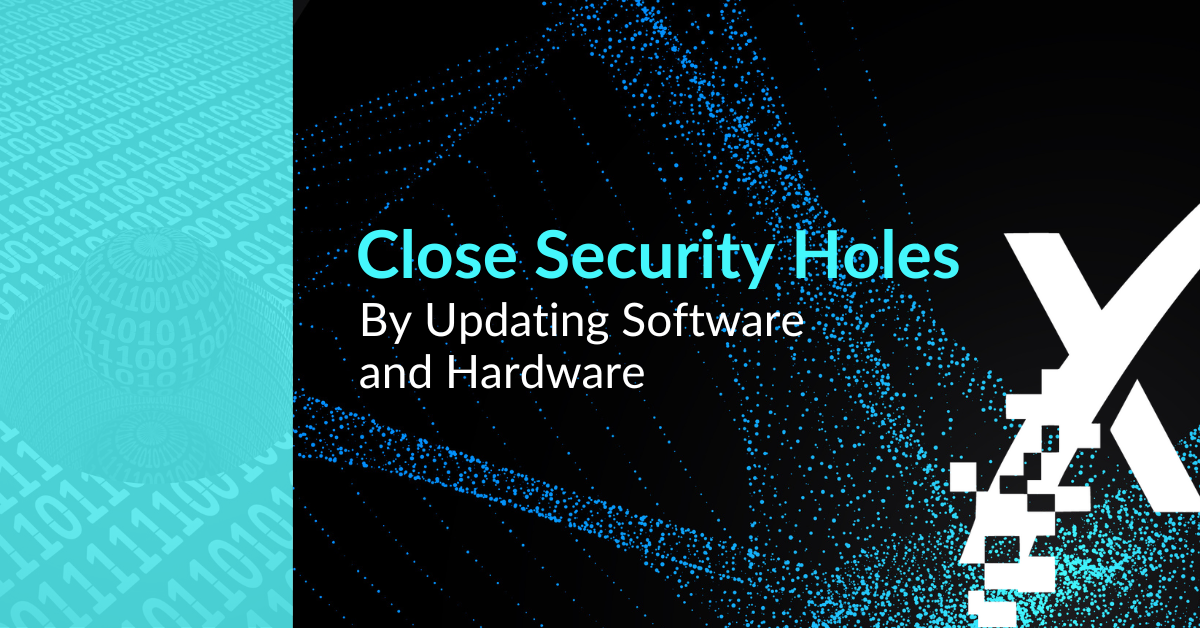Close Security Holes by Updating Software and Hardware

Sometimes the simplest things that you can do to defend your organization against cyber-attack get neglected. Take keeping software and hardware up to date for example. When you use unsupported software or fail to apply security patches, you’re creating holes where cyber criminals can enter. As for hardware, older equipment isn’t that good at running modern software, so you miss taking advantage of all of the security features that you have at your disposal.
How Do Cyber-Criminals Exploit Software?
When a software product is released, cyber criminals immediately search for vulnerabilities to exploit. When they find holes where they can sneak onto a computer or network, they either carry out a plan to download malware, look for a bigger target, or sell that access to others.
At the same time, the developer is consistently putting out “patches” to close these security holes. They do this until the software goes “out of support” and the patches stop.
Out-of-support software is a favorite target for hackers because they continue to find holes and they know the holes will never be patched. They especially like popular out-of-support software that lots of people use, like Windows 7, because it gives them a lot of computers to target.
The Problem with Outdated Hardware
When it comes to hardware, you have to think about it in connection with the software that is being used. When it gets to a certain age, older hardware doesn’t have the specs that are needed to optimally run modern software.
You also run into compatibility issues when you try to combine new and old computers and office equipment on your network. They’re just not all going to talk nice to each other.
Old hardware also impacts productivity. When your people have to wait on slow applications or deal with freezes and crashes, productivity won’t be the only thing at stake. Customer and employee satisfaction will be compromised too.
Using Old Hardware and Software Doesn’t Save Money
If using supported software and refreshing hardware is such an important layer in cybersecurity strategy, why do organizations let their computers and applications languish into old age?
Perceived cost savings is probably the most common reason. Some people think that running computers and software until they die is how to get your money’s worth.
Along with this is the mindset that business leaders and managers have that their organization is not a target for cyber-crime. Alternatively, they might know and understand how these practices make them vulnerable to more cyber risk, but they ignore it.
Ignoring the increasing risk of cyber attack isn’t a very good practice for executives who have the responsibility for managing overall business risk when you consider the likelihood and fallout of a potential attack.
- There’s a hacker attack every 39 seconds. University of Maryland
- The FBI reported a 300% increase in reported cybercrimes in 2020. FBI pdf
- Data breach costs increased from $3.86 million to $4.24 million in 2021. IBM
- The average cost of a data breach increased by $1.07 million due to remote work. IBM
Start Planning and Budgeting for Software and Hardware Updates
Keeping your software and hardware up to date is going to require investments but being proactive has many benefits. First of all, you’re implementing a cybersecurity best practice that’s vital to managing cyber risk. Second, you can use this practice to enable your employees with the technology tools they need to be their most productive.
Depending on where you are today, it might be a big expense to get everything up to date. After that, you can plan and budget for refreshes and better manage the expense.
Want More Ideas for Creating a Proactive IT Strategy?
Here at XPERTECHS, all of our clients get ongoing guidance to develop an IT strategy that creates a solid and secure IT foundation on which they can grow. If you’re not getting that from your IT support company, it’s time to up your game.
